Philodendron Spiritus Sancti is often considered pretty much the holy grail of all Philodendrons or “the Crown Jewel”. Not only are these hard to come by, but they also carry a pretty hefty price tag( most expensive plants in the world). This plant holds a special place on many wish lists. These stunning Aroids are an endangered species of genus Philodendron, native to the Brazilian state of Espirito Santo near the town of Domingos Martins in Brazil.
Unfortunately, the Philodendron SS is almost extinct in the wild and is undoubtedly endangered as only a handful of these plants (may be six) are known to remain in its natural habitat- all guarded on a privately known land called the Kautsky farm. However, today more of these plants are in cultivation. Philodendron Spiritus-Sancti has been successfully tissued cultured (TC) in Thailand, ensuring its availability to other plant collectors. However, you can also get your hand on these rare and highly coveted species through some online bidding websites.
Habitat & Ecology of Philodendron Spiritus-Sancti
Closely-Related Allied Species: Philodendron Verrucosum, Philodendron Florida Ghost, Philodendron Cordatum, Philodendron Minarum, Philodendron Moonlight, Philodendron White Knight, Philodendron White Princess,
Related Products:
Philodendron Spiritus-Sancti Plant Size
The plant features unique sword-like dark green leaves inspired by a Kori Blade. It can grow into a substantial beautiful plant as wild specimens are noticed reaching 20m (65’) tall and individual leaves exceeding 60cm (24”) long. The stalks (petioles) that attach a leaf to its stem – typically grow 12 to 24 inches long.
There were two main challenges that I faced with this plant. Firstly, I had to wait long enough to get my hands on this rare plant. Secondly, finding the right spot for mine because it is rather large with a pendent leaves-an elongated triangular shape that looks somewhat like bunny ears.
How to Care for Philodendron Spiritus Sancti?
Don’t be intimidated by this majestic house plant’s rarity and high price. From my experience, I can tell that Spiritus Sancti isn’t a fussy plant; it just needs a little effort and care from your side to flourish its number and size of leaves. It is just like growing other Philodendron species indoors as long as you’re able and willing to imitate their natural environment, in case you lack a greenhouse.
P. Spiritus Sancti is hemiepiphyte vine in the wild ( plant that grows upon another tree or object merely for physical support). It is an ultra-rare and slow grower with a handful of leaves. Hence, plant owners don’t want to loose any leaf and may wonder how to take care of this plant? In this article, we will explain the primary care needs so you may confidently raise this endangered plant.
Note: The care guide here is based on my early experience growing this plant indoors. The Philodendron Sancti adores humidity and wants a relatively moist and airy soil mix throughout the year.

Humidity and Temperature
P. Spiritus Sancti is native to the Brazilian rainforest, and being a tropical plant, it thrives in warm, consistent temperatures. P. Spiritus Sancti thrives at temperatures between 66°F to 76°F (19°C to 24°C). Around 75-80 degrees, I would say, is the sweet spot, pumping out new leaves in summer. They do not seem to mind the cooler temperature as well.
Our teammate Cameron has this plant in a greenhouse, and he noticed that the plant enjoys the cool season when the nights are dipping down to around 60 degrees and a little under sometimes 57°F or 55°F. To sum up, the plant stays fine between 60°F– 80 °F, typical home conditions as far as temperature goes. This plant grows much better in the summer when it’s a little warmer.
Moreover, this plant loves those nighttime drops, producing enormous leaves. However, encountering high temperatures may burn the foliage and promote excessive transpiration. Similarly, avoid drafty areas like ac vents and heating vents for your plant to thrive. For this tropical plant to thrive, keeping the temperature and humidity stable is the key.
Airoids are rainforest plants that want high humidity, and it’s really the key to getting lovely lush leaves. The humidifier would definitely keep it a little extra happy. However, it does well in average humidity inside your home, e.g. 50% and more, depending on where you live.
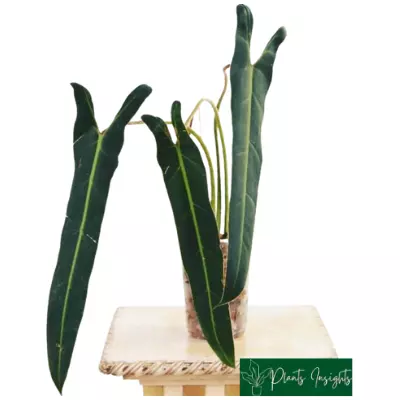
However, during winter, I run humidifiers for my plants to keep the humidity consistent and a space heater devoted to the plants to maintain the temperature (in the mid-70s Fahrenheit). In case of higher humidity(70%-80%), your plant is less likely to suffer from dehydration because of less transpiration rate.

Philodendron Spiritus-Sancti Potting Media
Like most Philodendrons, P. Spiritus Sancti thrives in well-draining, airy, and porous soil with a pH range between 5.6 to 7.5. It makes soil one of the most critical factors because this plant is hemiepiphytic and prone to root rot. Therefore, you must ensure it has a well-draining medium that it’s growing in, and lots of air gets to those roots.
Here is something that really works with my Aroids;
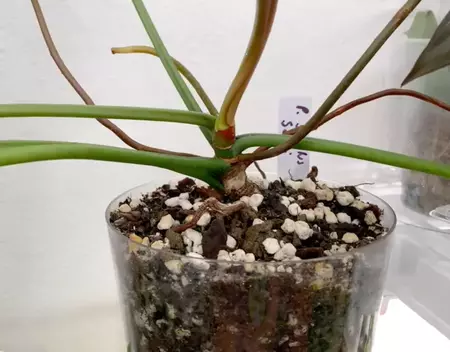
The purpose of this potting mix is to drain the excess water quickly and retain some moisture for the plant while concurrently allowing ample airflow, as Spiritus Sancti wouldn’t like to sit in a lot of soggy soil.
On the other hand, your regular potting soil mix can hold ample water, plus the density of the soil can reduce the airflow at the root zone, which is unsuitable for this epiphytic plant that is adapted to live above the ground. You can use any good Tropical Aroid soil mix available in the market.

Potting and Repotting( When should I Repot?)
Spiritus Sancti is hemiepiphytic, and it thrives in an airy pot letting airflow to the roots to avoid any root rot. You can plant this in ceramic ,terracotta or plastic pot with many holes for good drainage and aeration. If you have Sancti seedling, the two-inch plastic pot size, is perfect. Later they could probably be bumped up into maybe a four-inch pot, something maybe a little profound. You can move them into four-inch Sphagnum because sphagnum does an excellent job of keeping the moisture and everything, making it easy to take care of.
The key to choosing the pot is that it should be 1-2 inches larger than your plant’s root ball. Transparent pots with holes are also a great option as they help you monitor the root growth and let you know when to repot the plant.

Watering & Plant Hydration
One thing you’ll like about Philodendron Spiritus Sancti is that they are tough as nails and keep growing even if they dry out between watering schedules. However, I advise keeping the plant hydrated for it to thrive.
This plant is adapted to continuous humid conditions, and like most house plants, these can tolerate a bit of low humidity if you have excellent light and good water too for them.
As these plants are prone to root rot, we recommend keeping it moist with a wet feel but not soggy. You can also monitor the soil moisture by using a moisture meter to help ensure its water needs. We highly recommend watering these with RO water, never tap or anything like that.
When I got my specimen, it used to dry out quickly due to the very chunky soil mix(specially created for Spiritus Sancti). I had to water it twice a week for a couple of months, and once it was established, I watered it once a week and sometimes every 10 days.
If you find your Philodendron Spiritus Sancti dries out too fast, try soaking the pot and roots for up to 20 minutes on your watering day, followed by draining the pot completely. You can put a few pop bottle caps or pebbles under the pot to ensure maximum airflow to the roots.
Note
Adding a thin layer of sphagnum moss to the top layer of the pot helps in moisture retention. Otherwise, you may find the top layer dries faster than the lower layer. It could affect the even root growth if the humidity is low.
Try to be diligent and avoid prolonged drought or missed waterings which is expected in the case of airy potting mix.
Water quality
As we know, Philodendron Spiritus Sancti is a hemiepiphytic that grows in the wild, with the bulk of its roots attached or hanging from the side of trees, not the ground. So, it is adapted to feed on rainwater rather than groundwater.
Rainwater is pure, <10ppm TDS, and is slightly acidic with a pH of 5.5. Therefore, for great results, we recommend rainwater, distilled water, or reverse osmosis water (RO). I have noticed that lower pH in water can improve nutrient uptake in plants.

Does Philodendron Spiritus Sancti Need Sunlight?
Philodendron Spiritus Sancti loves dappled sunlight under the trees canopy, which also increases the humidity. Some people have this plant in their greenhouses inside their houses, whereas some keep it under grow lights. Well, in both ways, the plant doesn’t have any problem.
I noticed the plant can tolerate more light than other Aroids as it grows in a tropical climate on other trees under the upper canopy getting the bright light. It lets the plant capture ample energy followed by blooming, producing fruit and seed. In rainforests, the sky is usually cloudy, dispersing and screening the bright sunlight from reaching the plants.
Therefore, keeping that in mind, I take my plant outdoor and leave it to get a little bit of some morning sun for a couple of hours before the sun starts getting a little warm. Later, I put it under the shade of bigger plants in my greenhouse to get filtered sunlight. Unlike other plants grown in more bright conditions, this plant seems to like deep shade well, I mean, as deep as the shade gets in the greenhouse.

You must ensure the plant gets good light through the shade cloth and protection from the scorching sun. In ideal bright filtered light, the plant rewards you with really big bluish glaucus amazingness.
If the plant is indoors, you may give the direct sunlight through your house window for a couple of hours in the morning, and for the rest of the day, keep the plant under LED grow lights. ( any grow light will work great) Moreover, you can grow juvenile stage Spiritus Sancti indoors or start them out at least just right under a grow light. You can also use light sensor to check the intensity of the light – low to medium intensity light is preferable.
Effects of Inadequate/Excessive Sunlight
I would suggest examining the leaves’ color to monitor the light intensity. For instance, droopy or yellow leaves indicate the plant is getting too much light, and you need to reduce the light intensity or cut out some outdoor hours. Moreover, high intensity may burn the leaves resulting brown spots.
Leggy plant or smaller and faded leaves indicates the light is probably too low, and you need to increase it. The Chlorophyll won’t function properly . If your plant is near the window you need to be aware of the seasonal changes in light and temperature.

Fertilizer & Nutrients
Philodendrons Spiritus-Sancti plants do eat a lot as they dry out quickly because of the porous potting mix. For baby Spiritus-Sancti feeding fish fertilizer every couple of weeks makes them really happy, and they grow fast. Later you can feed the P. Spiritus-Sancti with slow-release fertilizer (SRF) to provide a steady supply of nutrients (mostly nitrogen)over an extended time. (Use the recommended amount mentioned on the container). You’re looking for foliage growth, so you probably want something high in nitrogen.
Moreover, you may acidify the water every second or third watering. You can also use soluble MSU orchid fertilizer (mainly nitrogen) for foliage growth. In addition, occasionally feeding a dose (1/8 tsp) of organic fertilizer mix (blend of bloodmeal, rock dust, and insect frass) into the soil would show good results. In the case of lack of fertilizer, the Spiritus-Sancti plants would stop growing, and their beautiful dark green foliage color may fade.
Philodendron Spiritus-Sancti Leaf Variation
Interestingly this plant features both narrow and broad leaves. Some Spiritus-Sancti possess slender leaves while others have wide leaves or could have both depending on the light intensity, humidity, or temperature. Seedlings and baby Sancti features fresh green foliage with some pink hint at the back of some leaves. However, as they grow, the foliage gets darker green, wider and elongated like bunny ears.


Pruning
As this plant is a slow grower and its leaves take ages to grow into long, dark green leaves like swords, so you don’t need to worry about the pruning. This plant possesses a handful of leaves, therefore you don’t need to prune any leaf unless it is necessary.
To prune your plant always use a sharp and sterilized knife or pruning Shear. If any leaf turns yellow or brown, you can prune that leaf so, that plant will use its energy on healthy leaves. You can simply grab the stem of a damaged leaf, pull it away from the plant, and cut it at the base. Remember to water your plant after pruning.

Flowering & Pollination of Philodendron Spiritus Sancti
As this plant is rare and only six plants are left in the wild, therefore until 2020 P. Spiritus Sancti was not successfully pollinated. However, in recent years Aroid gained, and in 2020 and 2021 two people (one from Brazil and the other from the U.S.A ) successfully pollinated a Spiritus-Sancti flower and produced viable seeds. After the successful collection of seeds, they offered the seedlings of Sancti at a reasonable cost.
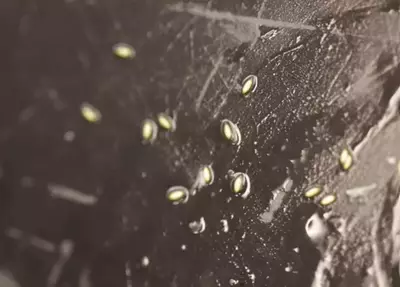
P. Spiritus Sancti doesn’t bloom at a young age . However mature Spiritus Sancti blooms large beautiful white and pink flowers that most likely open up at midnight and can be pollinated.
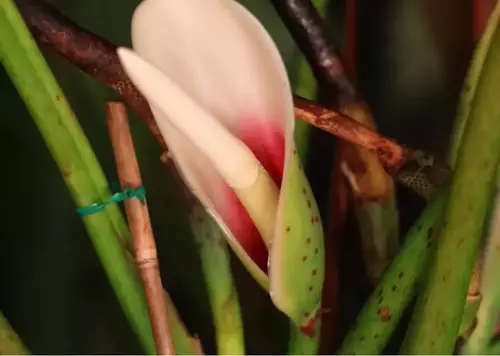
Pollination
When the female part opens the Spadex or the male part undergoes thermogenesis and if you feel this get slightly warm as the evening goes.
The female is receptive the first night and opens up – ready to be pollinated. At this stage, you can add the pollen from the last flower making sure to cover all those stigmas for successful pollination.
The pollination of this flower is a bit challenging as it must be pollinated as soon as the flower opens and spadix undergoes thermogenesis which is the signal for the receptivity of the flower. The pollination time is a few hours, therefore you need to be very cautious.
After pollination in a day or two, the pollens are produced at the top half of the spadix and you can collect the pollens if you want.
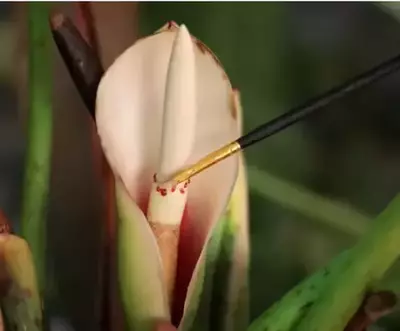
After 11 weeks it produces a nice fat juicy seed head that you can put in some water and squeeze to get all the seeds out of it and then separate them and can be planted in soil or sphagnum.
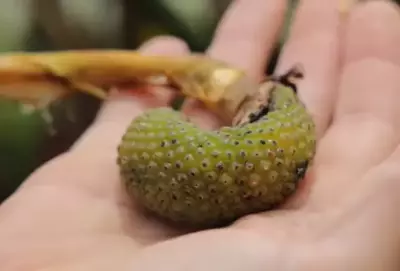
Keep in mind the above method is how very few people have successfully produced the seedling till now.
When Does Spiritus-Sancti Bloom?
Mature Spiritus-Sancti produces beautiful large white flowers with a hint of pink. It is reported that this plant flowers in November/December or near peak summer temperatures. Mines haven’t produced flowers yet, as it depends on the size and age of the plant. It is reported that P.Spiritus-Sancti flowers locally during November and December when there is a rainy season.
On the other hand, it has also been observed that cultivated plants in the Northern Hemisphere flowered in July. Since this plant is rare, limited information is available about this plant. Till now, only larger and more mature plants have bloomed.

Propagating Philodendron Spiritus-Sancti
Spiritus-Sancti can be propagated in various ways. As mentioned earlier, Spiritus Sancti was pollinated successfully, and its seedlings are available in the market. These seedlings gained popularity and were warmly welcomed by plant lovers. Moreover, tissue-cultured Spiritus-Sancti plants are also in circulation.
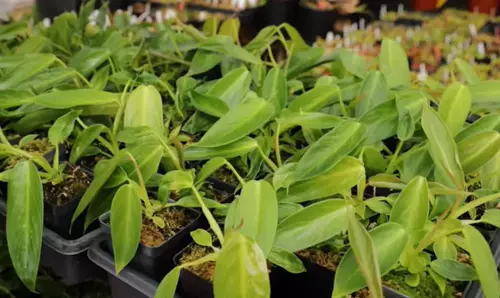
However, this plant’s most popular propagation method is through stem cutting or air layering.
Propagating by Stem Cutting
Most plant lovers prefer the stem cutting method for propagation as it is the easiest way. The suitable time to propagate this plant is spring.
You can follow the following steps for propagation.
1. Water your plant thoroughly before propagation.
2. Sterilize the scissors or Shear.
3. Select a healthy stem with a node (the starting point) and aerial root. Make sure the step has some leaves on it.
4. Carefully cut the stem at an angle of 45 and pull out the stem along with the aerial root.
5. Prepare a fresh and porous potting mix, including sphagnum peat moss mainly.
6. Plant the cutting into a well-draining potting mix about 2 inches deep. You can use a transparent pot to monitor the root growth.
7. After that, water the newly potted cutting thoroughly. Provide the optimal light and humidity for significant growth.
Propagation in Water Medium
Like other Philodendrons, you can put the cutting into the water in a glass jar. Keep the water clean and carefully monitor the root growth.
As soon as the plant grows significant roots, you can plant that cutting into the potting mix.
Propagation by Air Layering
Air Layering is another popular method of propagating Philodendrons. Follow the following steps for air layering.
Is Philodendron Spiritus Sancti toxic?
Yes, Philodendron Spirits Sancti is toxic to both humans and pets. Long sword like hanging leaves are attractive to pets, and they may try to chew on them. We recommend keeping this plant away at a safe distance from kids and pets.

Common Problems
Pests
Philodendron Spiritus Sancti is a tough plant and is pest- resistent. However, like other house plants, pests can also invade it if conditions are not favorable. The most common pests that may attack Spiritus Sancti are spider mites, mealybugs, thrips, and aphids.
Carefully inspect the back side of the leaves to identify infestations. In case of spider mites attacks, you will notice silky webs usually on the back side of the leaves.
If Mealybugs infect your plant, cotton white wax would be seen on the plant’s foliage. To get rid of pests, you can try some remedies such as wiping the leaves with a wet cloth and applying neem oil on the leaves.
Moreover, you can spray the insecticide on the leaves or use a cotton ball to rub the plant foliage with rubbing alcohol.
Root Rot
Philodendron Spiritus Sancti thrives in porous, well-draining soil. It is prone to root rot caused by overwatering or thick soil medium. Root rot may cause stunted growth, Yellowing, and unfurling leaves.
Therefore, after watering the plant, let the soil drain excess water. You can place the pot on bottle caps or pebbles for root aeration. Preferably use a transparent pot to monitor the roots, and always use porous, chunky potting mix soil medium. Give plants breathing space and don’t crowd the space with other plants.
Frequently asked Questions
Is Philodendron Spiritus Sancti Rare?
Philodendron Spiritus Sancti is very rare. Only a handful of these plant is in the wild ( probably six). While some are in cultivation . It is rare to find it sold in a garden center or nursery. Moreover , it is a slow grower and it’s propagation is challenging.
Why is Spiritus Sancti expensive?
Philodendron Spiritus Sancti plants are expensive because they are rare and are a slow grower. This plant is on the wish list of most plant lovers.
Moreover, the propagation of these plants is also challenging. However, these plants’ cutting and seedlings are affordable compared to mature plants.
How many Philodendron Spiritus-Sancti are there?
It is reported that only six of this specie are left in the wild. This plant is endangered species of Philodendron.
What is the rarest philodendron?
The rarest Philodendron is the Philodendron Spiritus Sancti as quite a handful of these plants are left in the wild. This is also one of the most expensive plants in the world.
How much is a Philodendron Spiritus Sancti?
The price of the Philodendron Spiritus-Sancti depends on the size of the plant. For instance, the seedlings are available at $500, while bigger plants cost thousands of dollars. Some vendors sold it as high as $12,000 or more.
Is this Philodendron Spiritus Sancti plant difficult to care for?
Interestingly these are easy to care for plants. However, they are prone to root rot. Therefore always choose a porous potting mix and well draining plant pot.


